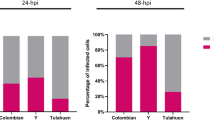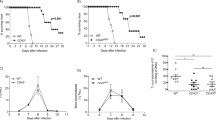Abstract
Background
Glycosylphosphatidylinositol (GPI) purified from Plasmodium falciparum has been shown to play an important role as a toxin in the pathology of malaria. Previous studies demonstrated cardiac involvement in patients suffering from severe malaria due to P. falciparum. Therefore, we tested the hypothesis that GPI induces apoptosis in cardiomyocytes.
Methods and results
By using TUNEL and caspase activity assays, we provided evidence for apoptosis induction in cardiomyocytes by P. falciparum GPI after 48 h of incubation. A similar result was obtained in heart cells of mice 48 h after in vivo injection of GPI. Gene expression analyses in GPI-treated cardiomyocytes showed an up-regulation of apoptotic genes (apaf-1, bax) and of a myocardial damage marker bnp (brain natriuretic peptide), while a down-regulation was observed for the anti-apoptotic gene bcl-2 and for the heat shock protein hsp70. In spite of inflammatory cytokine gene up-regulation by GPI, co-culture with peripheral mononuclear cells (PMNCs) did not change the results obtained with cardiomyocytes alone, indicating a direct effect of GPI on cardiac myocytes. Co-culture with non-myocytic cardiac cells (NMCCs) resulted in up-regulation of Hsp70 and Bcl-2 genes in GPI-treated cardiomyocytes but without repercussion on the apoptosis level. A malaria-infected patient, presenting fulminant heart failure showed typical signs of cardiac myocyte apoptosis demonstrating the clinical relevance of toxin induced heart damage for the lethality of malaria. Our studies performed in vitro and in mice suggest that the GPI could be responsible for cardiomyocyte apoptosis that occurred in this patient.
Conclusion
Plasmodium falciparum GPI-induced apoptosis might participate in the lethality of malaria.






Similar content being viewed by others
Notes
Man = mannose
References
World malaria report, 2005 http://rbm.who.int/wmr2005/
Ehrhardt S, Mockenhaupt FP, Anemana SD, Otchwemah RN, Wichmann D, Cramer JP, Bienzle U, Burchard GD, Brattig NW (2005) High levels of circulating cardiac proteins indicate cardiac impairment in African children with severe Plasmodium falciparum malaria. Microbes Infect 7:1204–1210
Ehrhardt S, Wichmann D, Hemmer CJ, Burchard GD, Brattig NW (2004) Circulating concentrations of cardiac proteins in complicated and uncomplicated Plasmodium falciparum malaria. Trop Med Int Health 9:1099–1103
McConville MJ, Ferguson MA (1993) The structure, biosynthesis and function of glycosylated phosphatidylinositols in the parasitic protozoa and higher eukaryotes. Biochem J 294:305–324
Schofield L, Hackett F (1993) Signal transduction in host cells by a glycosylphosphatidylinositol toxin of malaria parasites. J Exp Med 177:145–153
Schofield L, Novakovic S, Gerold P, Schwarz RT, McConville MJ, Tachado SD (1996) Glycosylphosphatidylinositol toxin of Plasmodium up-regulates intercellular adhesion molecule-1, vascular cell adhesion molecule-1, and E-selectin expression in vascular endothelial cells and increases leukocyte and parasite cytoadherence via tyrosine kinase-dependent signal transduction. J Immunol 156:1886–1896
Tachado SD, Gerold P, McConville MJ, Baldwin T, Quilici D, Schwarz RT, Schofield L (1996) Glycosylphosphatidylinositol toxin of Plasmodium induces nitric oxide synthase expression in macrophages and vascular endothelial cells by a protein tyrosine kinase-dependent and protein kinase C-dependent signaling pathway. J Immunol 156:1897–1907
Krishnegowda G, Hajjar AM, Zhu J, Douglass EJ, Uematsu S, Akira S, Woods AS, Gowda DC (2005) Induction of proinflammatory responses in macrophages by the glycosylphosphatidylinositols of Plasmodium falciparum: cell signaling receptors, glycosylphosphatidylinositol (GPI) structural requirement, and regulation of GPI activity. J Biol Chem 280:8606–8616
Vijaykumar M, Naik RS, Gowda DC (2001) Plasmodium falciparum glycosylphosphatidylinositol-induced TNF-alpha secretion by macrophages is mediated without membrane insertion or endocytosis. J Biol Chem 276:6909–6912
Guha M, Kumar S, Choubey V, Maity P, Bandyopadhyay U (2006) Apoptosis in liver during malaria: role of oxidative stress and implication of mitochondrial pathway. FASEB J 20:1224–1226
Helmby H, Jonsson G, Troye-Blomberg M (2000) Cellular changes and apoptosis in the spleens and peripheral blood of mice infected with blood-stage Plasmodium chabaudi chabaudi AS. Infect Immun 68:1485–1490
Guha M, Maity P, Choubey V, Mitra K, Reiter RJ, Bandyopadhyay U (2007) Melatonin inhibits free radical-mediated mitochondrial-dependent hepatocyte apoptosis and liver damage induced during malarial infection. J Pineal Res 43:372–381
Wichmann D, Schwarz RT, Ruppert V, Ehrhardt S, Cramer JP, Burchard GD, Maisch B, Debierre-Grockiego F (2007) Plasmodium falciparum glycosylphosphatidylinositol induces limited apoptosis in liver and spleen mouse tissue. Apoptosis 12:1037–1041
Huber SA, Sartini D (2005) Roles of tumor necrosis factor alpha (TNF-alpha) and the p55 TNF receptor in CD1d induction and coxsackievirus B3-induced myocarditis. J Virol 79:2659–2665
Maisch B, Richter A, Sandmoller A, Portig I, Pankuweit S (2005) Inflammatory dilated cardiomyopathy (DCMI). Herz 30:535–544
Schmidt A, Schwarz RT, Gerold P (1998) Plasmodium falciparum: asexual erythrocytic stages synthesize two structurally distinct free and protein-bound glycosylphosphatidylinositols in a maturation-dependent manner. Exp Parasitol 88:95–102
Dieckmann-Schuppert A, Bender S, Odenthal-Schnittler M, Bause E, Schwarz RT (1992) Apparent lack of N-glycosylation in the asexual intraerythrocytic stage of Plasmodium falciparum. Eur J Biochem 205:815–825
Gerold P, Dieckmann-Schuppert A, Schwarz RT (1994) Glycosylphosphatidylinositols synthesized by asexual erythrocytic stages of the malarial parasite, Plasmodium falciparum. Candidates for plasmodial glycosylphosphatidylinositol membrane anchor precursors and pathogenicity factors. J Biol Chem 269:2597–2606
Debierre-Grockiego F, Schofield L, Azzouz N, Schmidt J, Santos de Macedo C, Ferguson MA, Schwarz RT (2006) Fatty acids from Plasmodium falciparum down-regulate the toxic activity of malaria glycosylphosphatidylinositols. Infect Immun 74:5487–5496
Folch J, Lees M, Sloane Stanley GH (1957) A simple method for the isolation and purification of total lipids from animal tissues. J Biol Chem 226:497–509
Li HL, Suzuki J, Bayna E, Zhang FM, Dalle Molle E, Clark A, Engler RL, Lew WY (2002) Lipopolysaccharide induces apoptosis in adult rat ventricular myocytes via cardiac AT(1) receptors. Am J Physiol Heart Circ Physiol 283:H461–H467
Wang TN, Ge YK, Li JY, Zeng XH, Zheng XX (2007) B-Type natriuretic peptide enhances mild hypoxia-induced apoptotic cell death in cardiomyocytes. Biol Pharm Bull 30:1084–1090
Jiang B, Xiao W, Shi Y, Liu M, Xiao X (2005) Heat shock pretreatment inhibited the release of Smac/DIABLO from mitochondria and apoptosis induced by hydrogen peroxide in cardiomyocytes and C2C12 myogenic cells. Cell Stress Chaperones 10:252–262
Ravagnan L, Gurbuxani S, Susin SA, Maisse C, Daugas E, Zamzami N, Mak T, Jaattela M, Penninger JM, Garrido C, Kroemer G (2001) Heat-shock protein 70 antagonizes apoptosis-inducing factor. Nat Cell Biol 3:839–843
Schofield L, Hewitt MC, Evans K, Siomos MA, Seeberger PH (2002) Synthetic GPI as a candidate anti-toxic vaccine in a model of malaria. Nature 418:785–789
Acknowledgements
This work was supported by the Deutsche Forschungsgemeinschaft.
Author information
Authors and Affiliations
Corresponding author
Additional information
Kathrin Wennicke and Françoise Debierre-Grockiego contributed equally to this work.
Rights and permissions
About this article
Cite this article
Wennicke, K., Debierre-Grockiego, F., Wichmann, D. et al. Glycosylphosphatidylinositol-induced cardiac myocyte death might contribute to the fatal outcome of Plasmodium falciparum malaria. Apoptosis 13, 857–866 (2008). https://doi.org/10.1007/s10495-008-0217-6
Published:
Issue Date:
DOI: https://doi.org/10.1007/s10495-008-0217-6




